Strategic Management and Leadership: Report on Workplace Strategies
VerifiedAdded on 2020/04/15
|10
|2107
|52
Report
AI Summary
This report on Strategic Management and Leadership delves into various aspects of organizational behavior and management practices. It addresses the importance of a positive organizational culture, emphasizing its role in managing values, ethics, and employee satisfaction, ultimately boosting productivity. The report contrasts strategic and operational plans, highlighting their distinct objectives and focuses. It then explores the significance of human resource planning, including staff management, budgetary requirements, and the development of human resource plans to align with strategic goals. The report also discusses workplace policies, procedures, and their impact on workforce efficiency and employee rights. Furthermore, it examines the benefits of effective workplaces, team working, and the consequences of poor teamwork. The report also covers effective communication skills, including verbal, non-verbal, and written communication, along with the LACE method for improved listening and communication. It also addresses communication barriers and relevant workplace legislation such as the Health and Safety at Work Act 1974 and workplace regulations 1992. Finally, the report emphasizes the purpose of workplace policies in aligning employees with organizational standards.
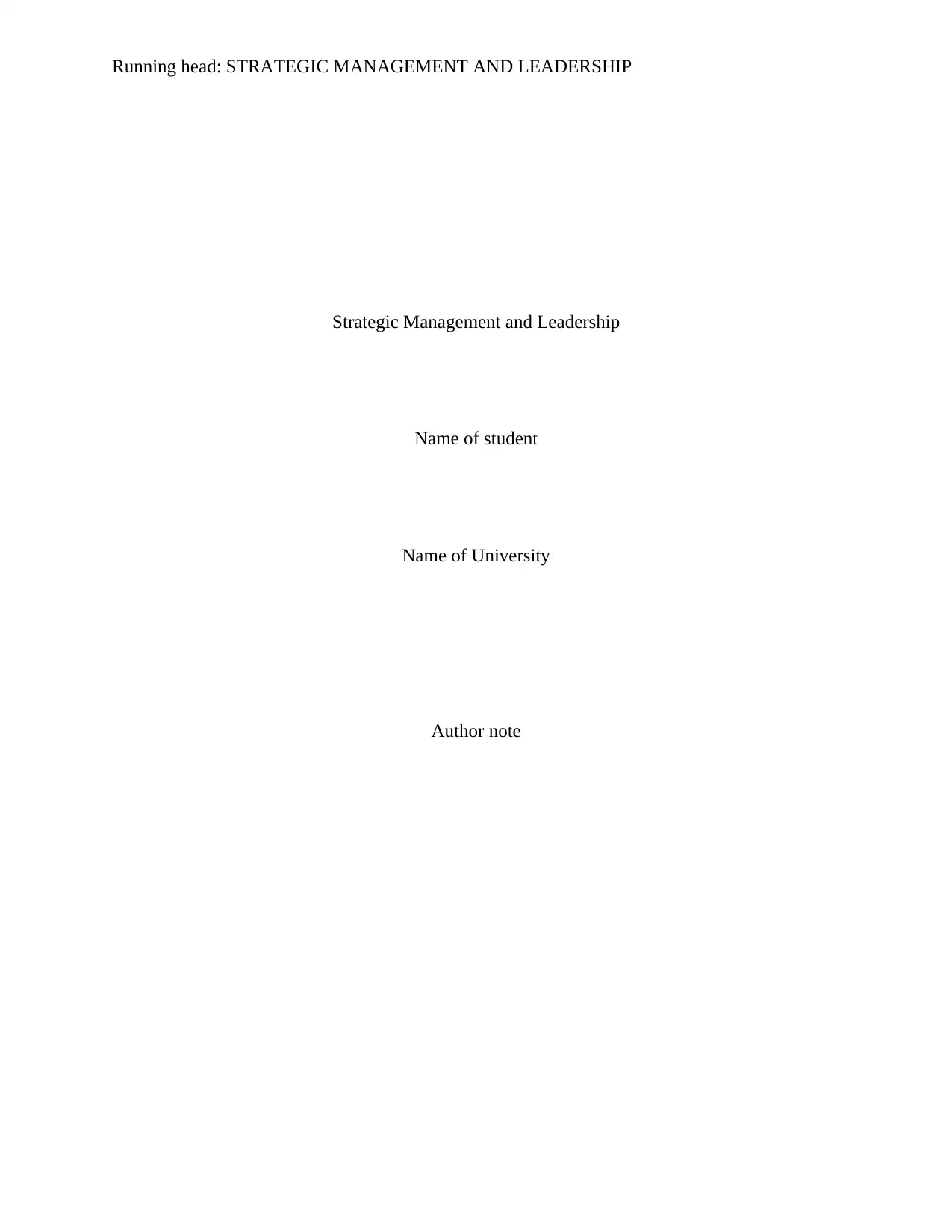
Running head: STRATEGIC MANAGEMENT AND LEADERSHIP
Strategic Management and Leadership
Name of student
Name of University
Author note
Strategic Management and Leadership
Name of student
Name of University
Author note
Paraphrase This Document
Need a fresh take? Get an instant paraphrase of this document with our AI Paraphraser
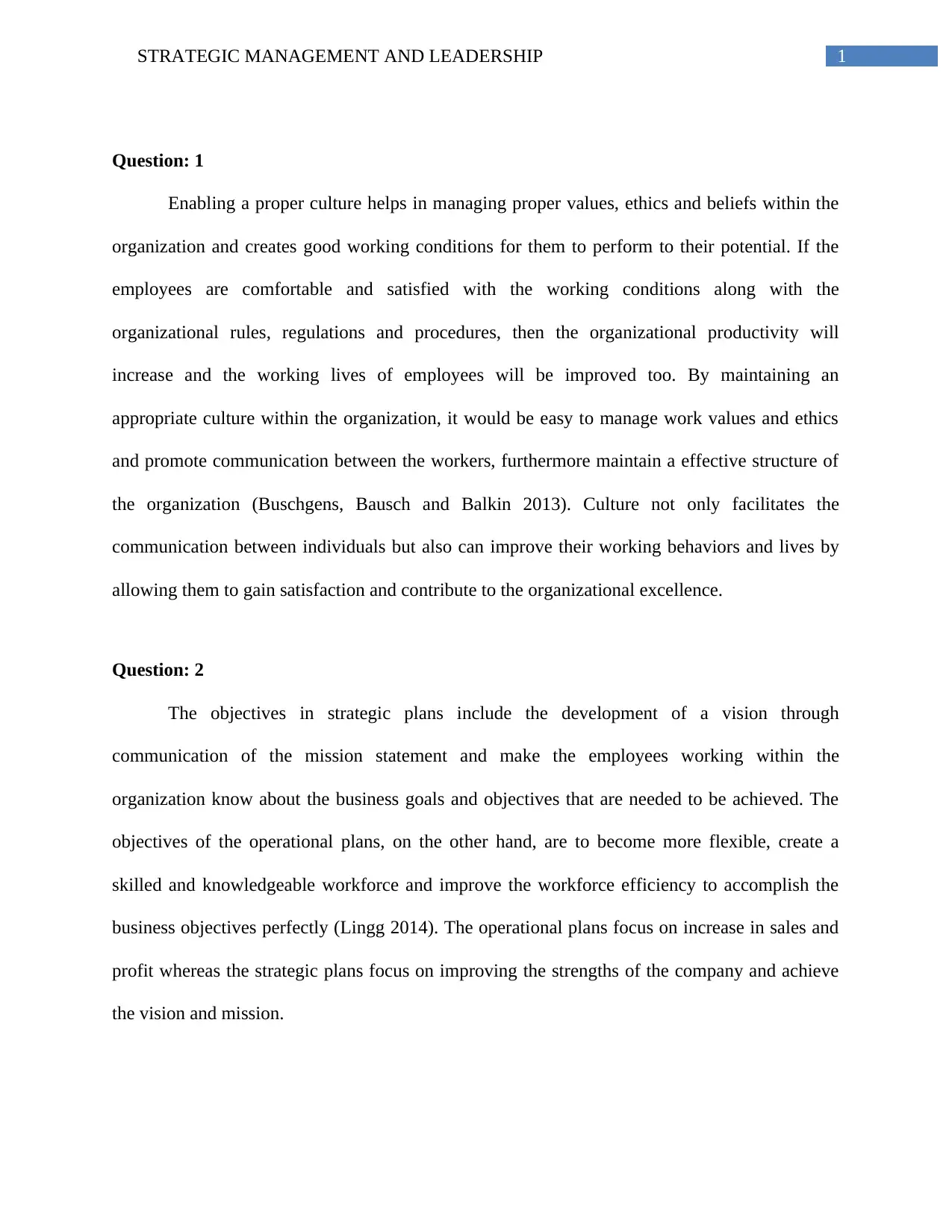
1STRATEGIC MANAGEMENT AND LEADERSHIP
Question: 1
Enabling a proper culture helps in managing proper values, ethics and beliefs within the
organization and creates good working conditions for them to perform to their potential. If the
employees are comfortable and satisfied with the working conditions along with the
organizational rules, regulations and procedures, then the organizational productivity will
increase and the working lives of employees will be improved too. By maintaining an
appropriate culture within the organization, it would be easy to manage work values and ethics
and promote communication between the workers, furthermore maintain a effective structure of
the organization (Buschgens, Bausch and Balkin 2013). Culture not only facilitates the
communication between individuals but also can improve their working behaviors and lives by
allowing them to gain satisfaction and contribute to the organizational excellence.
Question: 2
The objectives in strategic plans include the development of a vision through
communication of the mission statement and make the employees working within the
organization know about the business goals and objectives that are needed to be achieved. The
objectives of the operational plans, on the other hand, are to become more flexible, create a
skilled and knowledgeable workforce and improve the workforce efficiency to accomplish the
business objectives perfectly (Lingg 2014). The operational plans focus on increase in sales and
profit whereas the strategic plans focus on improving the strengths of the company and achieve
the vision and mission.
Question: 1
Enabling a proper culture helps in managing proper values, ethics and beliefs within the
organization and creates good working conditions for them to perform to their potential. If the
employees are comfortable and satisfied with the working conditions along with the
organizational rules, regulations and procedures, then the organizational productivity will
increase and the working lives of employees will be improved too. By maintaining an
appropriate culture within the organization, it would be easy to manage work values and ethics
and promote communication between the workers, furthermore maintain a effective structure of
the organization (Buschgens, Bausch and Balkin 2013). Culture not only facilitates the
communication between individuals but also can improve their working behaviors and lives by
allowing them to gain satisfaction and contribute to the organizational excellence.
Question: 2
The objectives in strategic plans include the development of a vision through
communication of the mission statement and make the employees working within the
organization know about the business goals and objectives that are needed to be achieved. The
objectives of the operational plans, on the other hand, are to become more flexible, create a
skilled and knowledgeable workforce and improve the workforce efficiency to accomplish the
business objectives perfectly (Lingg 2014). The operational plans focus on increase in sales and
profit whereas the strategic plans focus on improving the strengths of the company and achieve
the vision and mission.
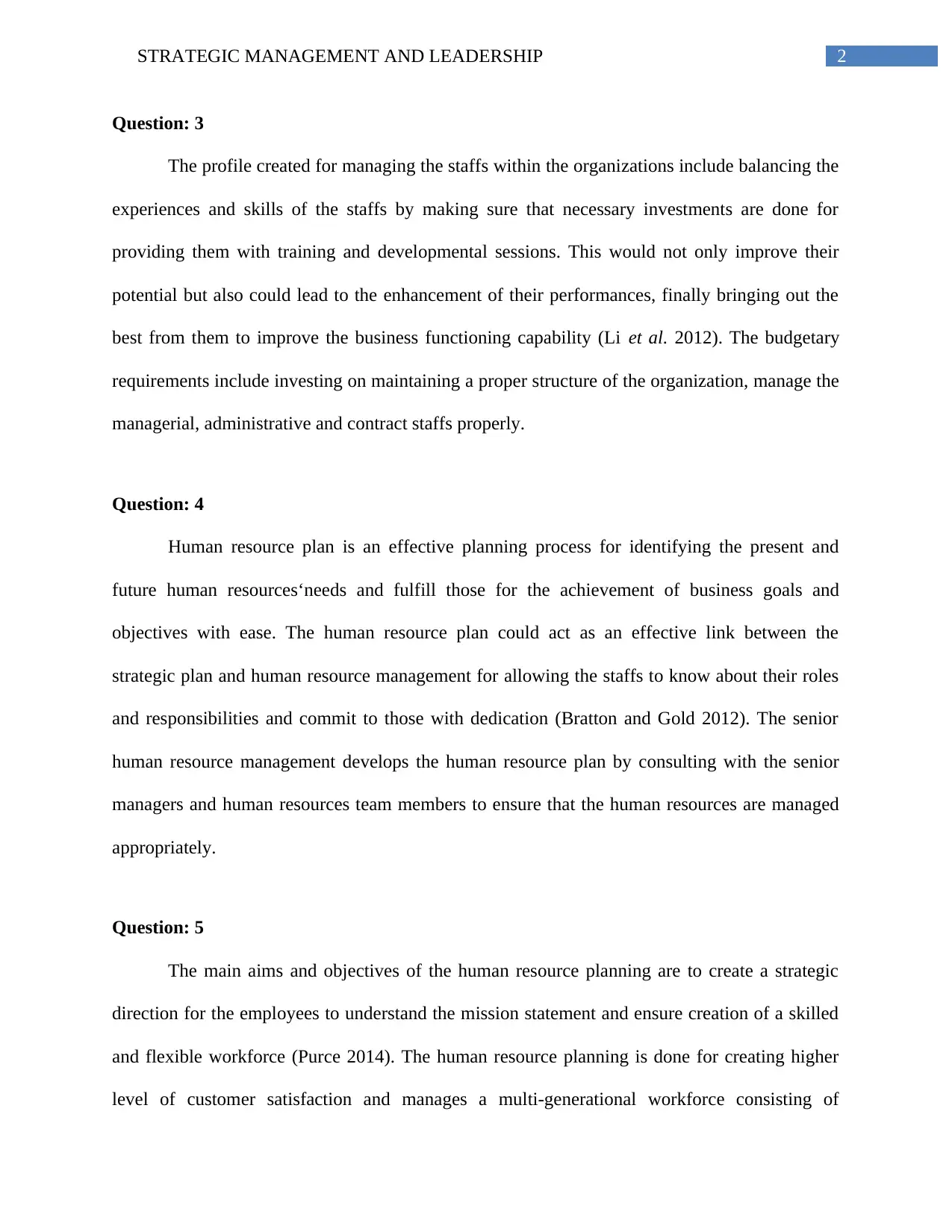
2STRATEGIC MANAGEMENT AND LEADERSHIP
Question: 3
The profile created for managing the staffs within the organizations include balancing the
experiences and skills of the staffs by making sure that necessary investments are done for
providing them with training and developmental sessions. This would not only improve their
potential but also could lead to the enhancement of their performances, finally bringing out the
best from them to improve the business functioning capability (Li et al. 2012). The budgetary
requirements include investing on maintaining a proper structure of the organization, manage the
managerial, administrative and contract staffs properly.
Question: 4
Human resource plan is an effective planning process for identifying the present and
future human resources‘needs and fulfill those for the achievement of business goals and
objectives with ease. The human resource plan could act as an effective link between the
strategic plan and human resource management for allowing the staffs to know about their roles
and responsibilities and commit to those with dedication (Bratton and Gold 2012). The senior
human resource management develops the human resource plan by consulting with the senior
managers and human resources team members to ensure that the human resources are managed
appropriately.
Question: 5
The main aims and objectives of the human resource planning are to create a strategic
direction for the employees to understand the mission statement and ensure creation of a skilled
and flexible workforce (Purce 2014). The human resource planning is done for creating higher
level of customer satisfaction and manages a multi-generational workforce consisting of
Question: 3
The profile created for managing the staffs within the organizations include balancing the
experiences and skills of the staffs by making sure that necessary investments are done for
providing them with training and developmental sessions. This would not only improve their
potential but also could lead to the enhancement of their performances, finally bringing out the
best from them to improve the business functioning capability (Li et al. 2012). The budgetary
requirements include investing on maintaining a proper structure of the organization, manage the
managerial, administrative and contract staffs properly.
Question: 4
Human resource plan is an effective planning process for identifying the present and
future human resources‘needs and fulfill those for the achievement of business goals and
objectives with ease. The human resource plan could act as an effective link between the
strategic plan and human resource management for allowing the staffs to know about their roles
and responsibilities and commit to those with dedication (Bratton and Gold 2012). The senior
human resource management develops the human resource plan by consulting with the senior
managers and human resources team members to ensure that the human resources are managed
appropriately.
Question: 5
The main aims and objectives of the human resource planning are to create a strategic
direction for the employees to understand the mission statement and ensure creation of a skilled
and flexible workforce (Purce 2014). The human resource planning is done for creating higher
level of customer satisfaction and manages a multi-generational workforce consisting of
⊘ This is a preview!⊘
Do you want full access?
Subscribe today to unlock all pages.

Trusted by 1+ million students worldwide
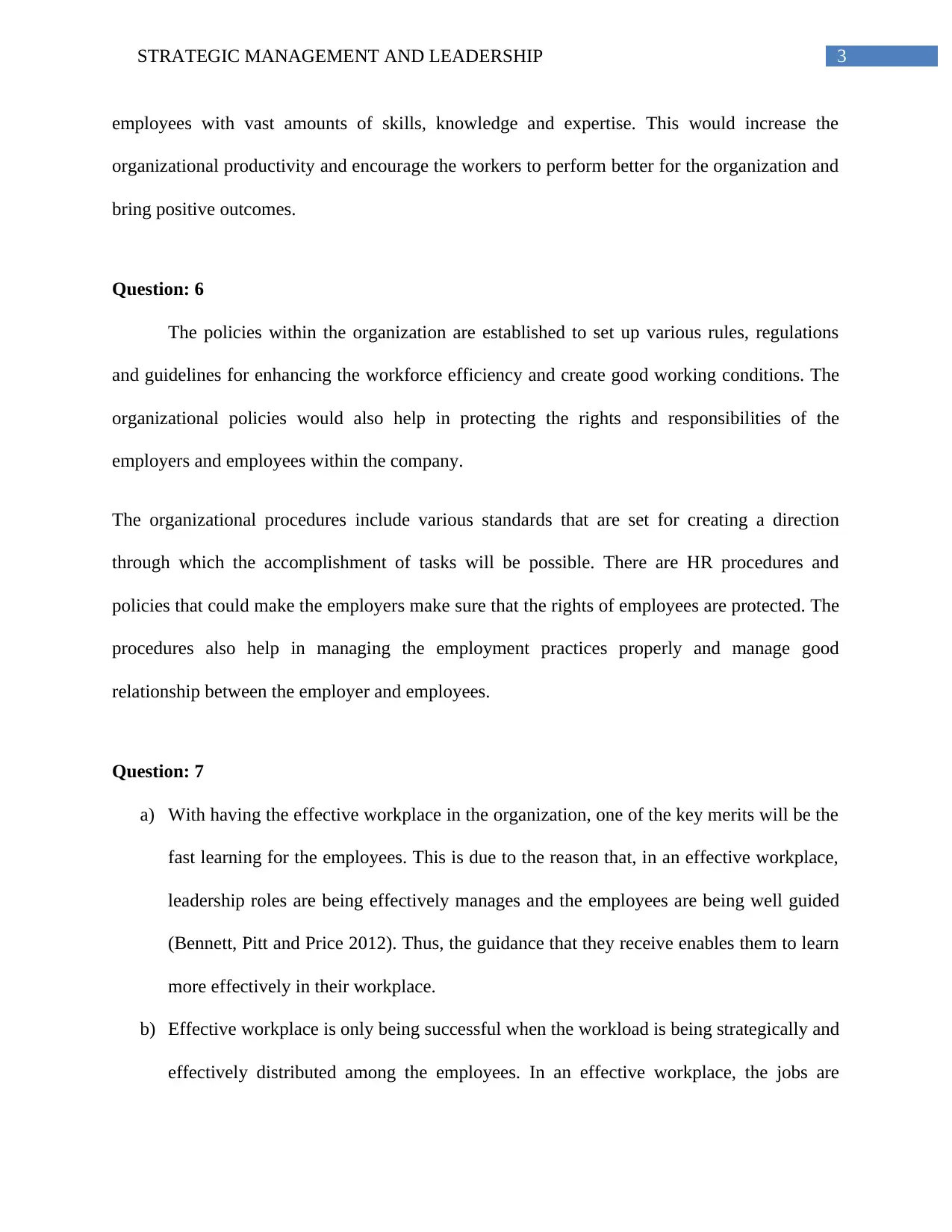
3STRATEGIC MANAGEMENT AND LEADERSHIP
employees with vast amounts of skills, knowledge and expertise. This would increase the
organizational productivity and encourage the workers to perform better for the organization and
bring positive outcomes.
Question: 6
The policies within the organization are established to set up various rules, regulations
and guidelines for enhancing the workforce efficiency and create good working conditions. The
organizational policies would also help in protecting the rights and responsibilities of the
employers and employees within the company.
The organizational procedures include various standards that are set for creating a direction
through which the accomplishment of tasks will be possible. There are HR procedures and
policies that could make the employers make sure that the rights of employees are protected. The
procedures also help in managing the employment practices properly and manage good
relationship between the employer and employees.
Question: 7
a) With having the effective workplace in the organization, one of the key merits will be the
fast learning for the employees. This is due to the reason that, in an effective workplace,
leadership roles are being effectively manages and the employees are being well guided
(Bennett, Pitt and Price 2012). Thus, the guidance that they receive enables them to learn
more effectively in their workplace.
b) Effective workplace is only being successful when the workload is being strategically and
effectively distributed among the employees. In an effective workplace, the jobs are
employees with vast amounts of skills, knowledge and expertise. This would increase the
organizational productivity and encourage the workers to perform better for the organization and
bring positive outcomes.
Question: 6
The policies within the organization are established to set up various rules, regulations
and guidelines for enhancing the workforce efficiency and create good working conditions. The
organizational policies would also help in protecting the rights and responsibilities of the
employers and employees within the company.
The organizational procedures include various standards that are set for creating a direction
through which the accomplishment of tasks will be possible. There are HR procedures and
policies that could make the employers make sure that the rights of employees are protected. The
procedures also help in managing the employment practices properly and manage good
relationship between the employer and employees.
Question: 7
a) With having the effective workplace in the organization, one of the key merits will be the
fast learning for the employees. This is due to the reason that, in an effective workplace,
leadership roles are being effectively manages and the employees are being well guided
(Bennett, Pitt and Price 2012). Thus, the guidance that they receive enables them to learn
more effectively in their workplace.
b) Effective workplace is only being successful when the workload is being strategically and
effectively distributed among the employees. In an effective workplace, the jobs are
Paraphrase This Document
Need a fresh take? Get an instant paraphrase of this document with our AI Paraphraser
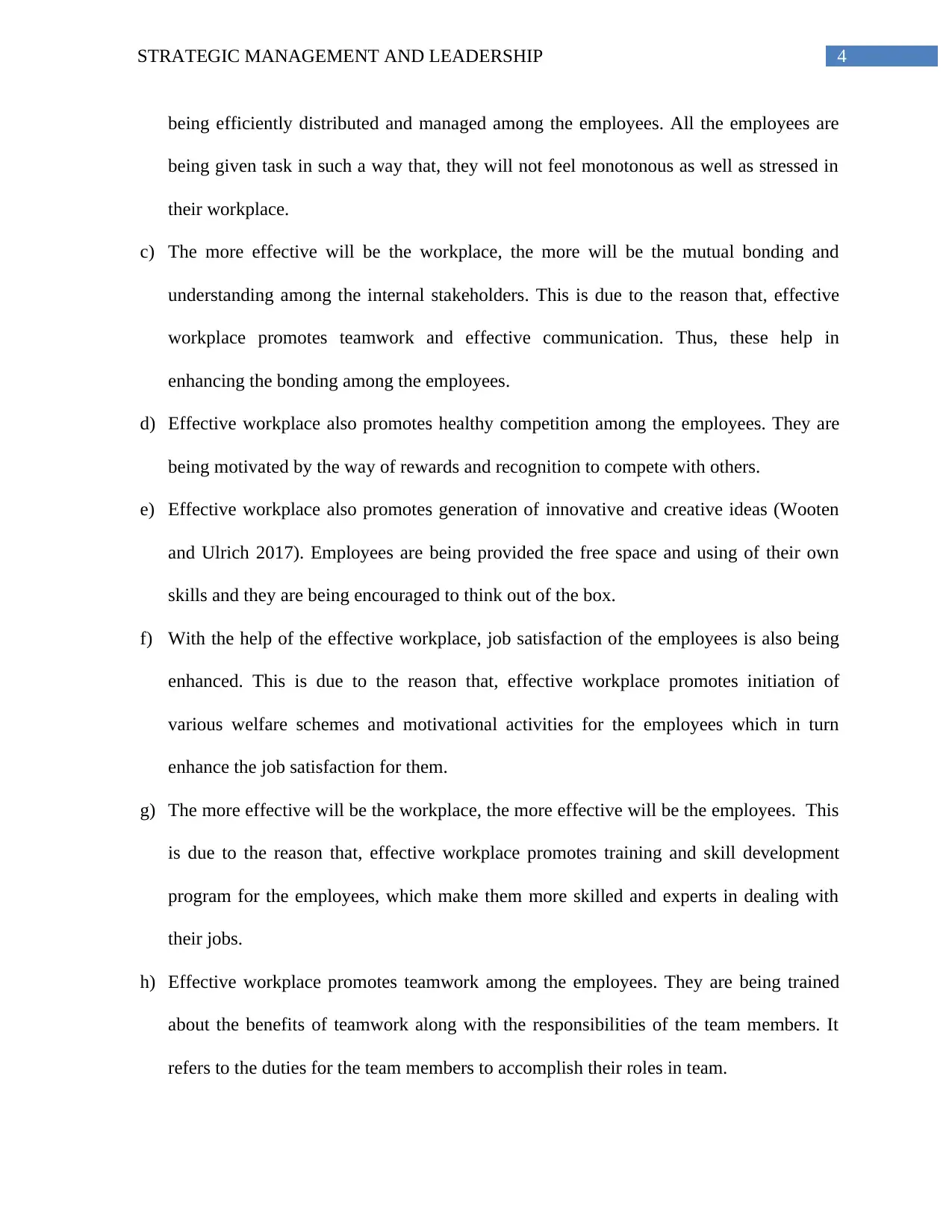
4STRATEGIC MANAGEMENT AND LEADERSHIP
being efficiently distributed and managed among the employees. All the employees are
being given task in such a way that, they will not feel monotonous as well as stressed in
their workplace.
c) The more effective will be the workplace, the more will be the mutual bonding and
understanding among the internal stakeholders. This is due to the reason that, effective
workplace promotes teamwork and effective communication. Thus, these help in
enhancing the bonding among the employees.
d) Effective workplace also promotes healthy competition among the employees. They are
being motivated by the way of rewards and recognition to compete with others.
e) Effective workplace also promotes generation of innovative and creative ideas (Wooten
and Ulrich 2017). Employees are being provided the free space and using of their own
skills and they are being encouraged to think out of the box.
f) With the help of the effective workplace, job satisfaction of the employees is also being
enhanced. This is due to the reason that, effective workplace promotes initiation of
various welfare schemes and motivational activities for the employees which in turn
enhance the job satisfaction for them.
g) The more effective will be the workplace, the more effective will be the employees. This
is due to the reason that, effective workplace promotes training and skill development
program for the employees, which make them more skilled and experts in dealing with
their jobs.
h) Effective workplace promotes teamwork among the employees. They are being trained
about the benefits of teamwork along with the responsibilities of the team members. It
refers to the duties for the team members to accomplish their roles in team.
being efficiently distributed and managed among the employees. All the employees are
being given task in such a way that, they will not feel monotonous as well as stressed in
their workplace.
c) The more effective will be the workplace, the more will be the mutual bonding and
understanding among the internal stakeholders. This is due to the reason that, effective
workplace promotes teamwork and effective communication. Thus, these help in
enhancing the bonding among the employees.
d) Effective workplace also promotes healthy competition among the employees. They are
being motivated by the way of rewards and recognition to compete with others.
e) Effective workplace also promotes generation of innovative and creative ideas (Wooten
and Ulrich 2017). Employees are being provided the free space and using of their own
skills and they are being encouraged to think out of the box.
f) With the help of the effective workplace, job satisfaction of the employees is also being
enhanced. This is due to the reason that, effective workplace promotes initiation of
various welfare schemes and motivational activities for the employees which in turn
enhance the job satisfaction for them.
g) The more effective will be the workplace, the more effective will be the employees. This
is due to the reason that, effective workplace promotes training and skill development
program for the employees, which make them more skilled and experts in dealing with
their jobs.
h) Effective workplace promotes teamwork among the employees. They are being trained
about the benefits of teamwork along with the responsibilities of the team members. It
refers to the duties for the team members to accomplish their roles in team.
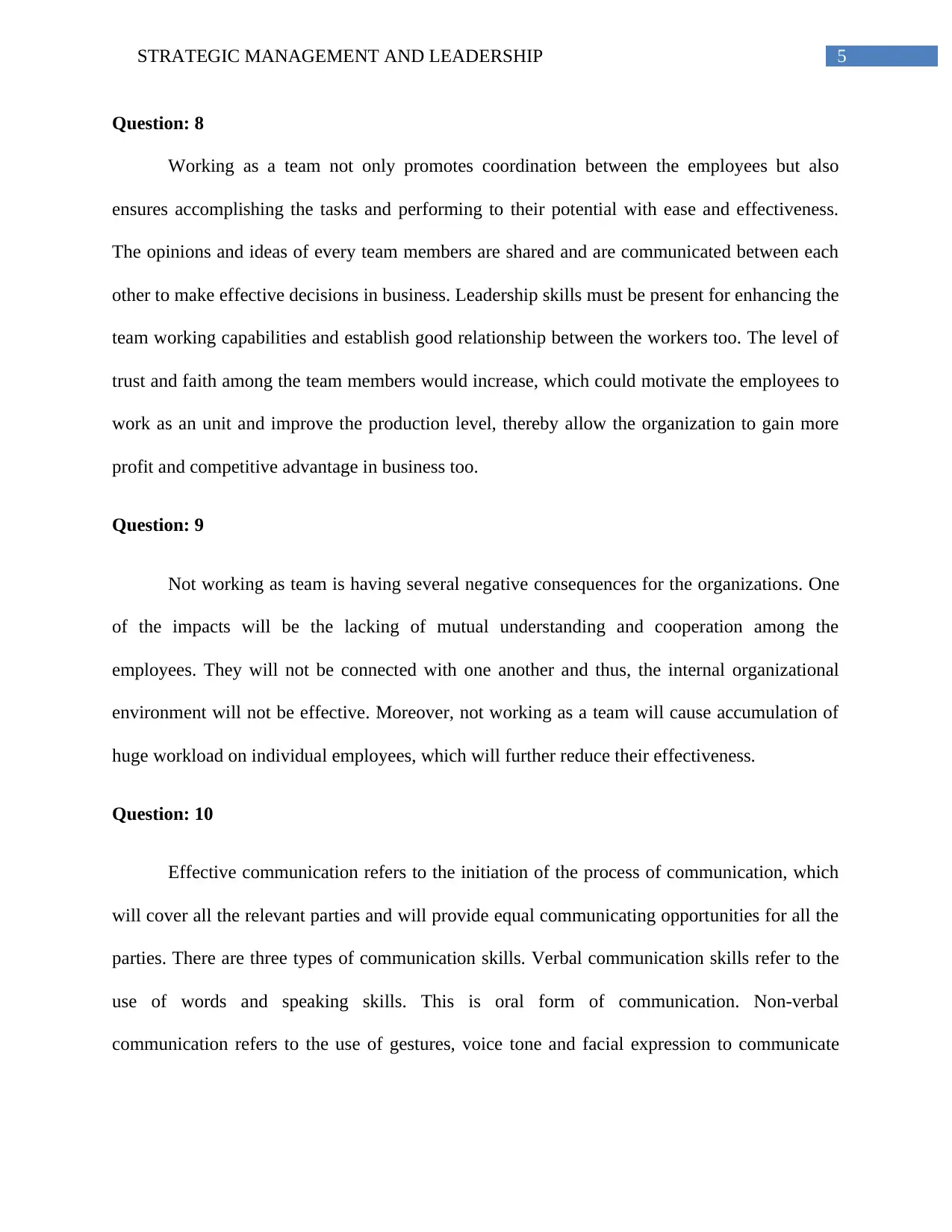
5STRATEGIC MANAGEMENT AND LEADERSHIP
Question: 8
Working as a team not only promotes coordination between the employees but also
ensures accomplishing the tasks and performing to their potential with ease and effectiveness.
The opinions and ideas of every team members are shared and are communicated between each
other to make effective decisions in business. Leadership skills must be present for enhancing the
team working capabilities and establish good relationship between the workers too. The level of
trust and faith among the team members would increase, which could motivate the employees to
work as an unit and improve the production level, thereby allow the organization to gain more
profit and competitive advantage in business too.
Question: 9
Not working as team is having several negative consequences for the organizations. One
of the impacts will be the lacking of mutual understanding and cooperation among the
employees. They will not be connected with one another and thus, the internal organizational
environment will not be effective. Moreover, not working as a team will cause accumulation of
huge workload on individual employees, which will further reduce their effectiveness.
Question: 10
Effective communication refers to the initiation of the process of communication, which
will cover all the relevant parties and will provide equal communicating opportunities for all the
parties. There are three types of communication skills. Verbal communication skills refer to the
use of words and speaking skills. This is oral form of communication. Non-verbal
communication refers to the use of gestures, voice tone and facial expression to communicate
Question: 8
Working as a team not only promotes coordination between the employees but also
ensures accomplishing the tasks and performing to their potential with ease and effectiveness.
The opinions and ideas of every team members are shared and are communicated between each
other to make effective decisions in business. Leadership skills must be present for enhancing the
team working capabilities and establish good relationship between the workers too. The level of
trust and faith among the team members would increase, which could motivate the employees to
work as an unit and improve the production level, thereby allow the organization to gain more
profit and competitive advantage in business too.
Question: 9
Not working as team is having several negative consequences for the organizations. One
of the impacts will be the lacking of mutual understanding and cooperation among the
employees. They will not be connected with one another and thus, the internal organizational
environment will not be effective. Moreover, not working as a team will cause accumulation of
huge workload on individual employees, which will further reduce their effectiveness.
Question: 10
Effective communication refers to the initiation of the process of communication, which
will cover all the relevant parties and will provide equal communicating opportunities for all the
parties. There are three types of communication skills. Verbal communication skills refer to the
use of words and speaking skills. This is oral form of communication. Non-verbal
communication refers to the use of gestures, voice tone and facial expression to communicate
⊘ This is a preview!⊘
Do you want full access?
Subscribe today to unlock all pages.

Trusted by 1+ million students worldwide
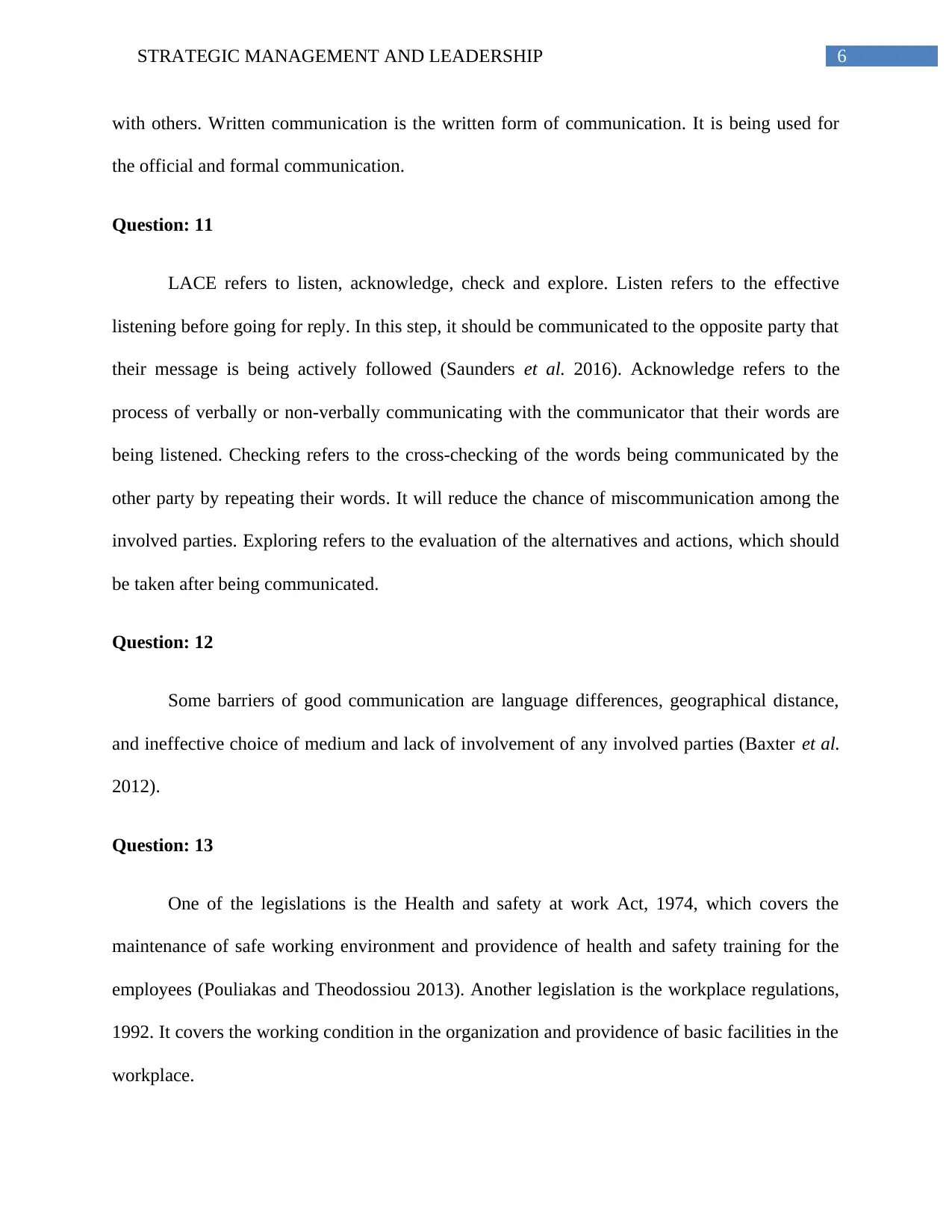
6STRATEGIC MANAGEMENT AND LEADERSHIP
with others. Written communication is the written form of communication. It is being used for
the official and formal communication.
Question: 11
LACE refers to listen, acknowledge, check and explore. Listen refers to the effective
listening before going for reply. In this step, it should be communicated to the opposite party that
their message is being actively followed (Saunders et al. 2016). Acknowledge refers to the
process of verbally or non-verbally communicating with the communicator that their words are
being listened. Checking refers to the cross-checking of the words being communicated by the
other party by repeating their words. It will reduce the chance of miscommunication among the
involved parties. Exploring refers to the evaluation of the alternatives and actions, which should
be taken after being communicated.
Question: 12
Some barriers of good communication are language differences, geographical distance,
and ineffective choice of medium and lack of involvement of any involved parties (Baxter et al.
2012).
Question: 13
One of the legislations is the Health and safety at work Act, 1974, which covers the
maintenance of safe working environment and providence of health and safety training for the
employees (Pouliakas and Theodossiou 2013). Another legislation is the workplace regulations,
1992. It covers the working condition in the organization and providence of basic facilities in the
workplace.
with others. Written communication is the written form of communication. It is being used for
the official and formal communication.
Question: 11
LACE refers to listen, acknowledge, check and explore. Listen refers to the effective
listening before going for reply. In this step, it should be communicated to the opposite party that
their message is being actively followed (Saunders et al. 2016). Acknowledge refers to the
process of verbally or non-verbally communicating with the communicator that their words are
being listened. Checking refers to the cross-checking of the words being communicated by the
other party by repeating their words. It will reduce the chance of miscommunication among the
involved parties. Exploring refers to the evaluation of the alternatives and actions, which should
be taken after being communicated.
Question: 12
Some barriers of good communication are language differences, geographical distance,
and ineffective choice of medium and lack of involvement of any involved parties (Baxter et al.
2012).
Question: 13
One of the legislations is the Health and safety at work Act, 1974, which covers the
maintenance of safe working environment and providence of health and safety training for the
employees (Pouliakas and Theodossiou 2013). Another legislation is the workplace regulations,
1992. It covers the working condition in the organization and providence of basic facilities in the
workplace.
Paraphrase This Document
Need a fresh take? Get an instant paraphrase of this document with our AI Paraphraser
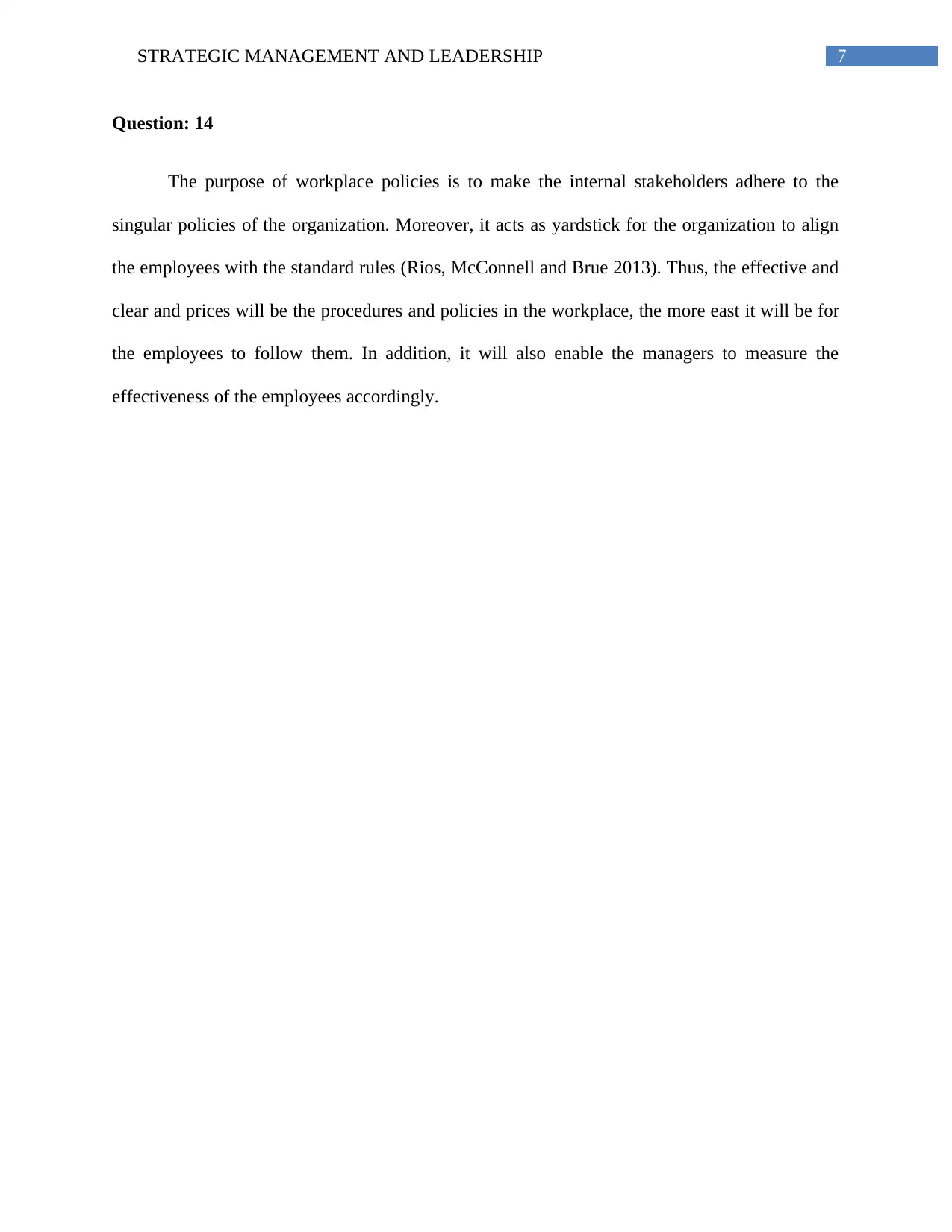
7STRATEGIC MANAGEMENT AND LEADERSHIP
Question: 14
The purpose of workplace policies is to make the internal stakeholders adhere to the
singular policies of the organization. Moreover, it acts as yardstick for the organization to align
the employees with the standard rules (Rios, McConnell and Brue 2013). Thus, the effective and
clear and prices will be the procedures and policies in the workplace, the more east it will be for
the employees to follow them. In addition, it will also enable the managers to measure the
effectiveness of the employees accordingly.
Question: 14
The purpose of workplace policies is to make the internal stakeholders adhere to the
singular policies of the organization. Moreover, it acts as yardstick for the organization to align
the employees with the standard rules (Rios, McConnell and Brue 2013). Thus, the effective and
clear and prices will be the procedures and policies in the workplace, the more east it will be for
the employees to follow them. In addition, it will also enable the managers to measure the
effectiveness of the employees accordingly.
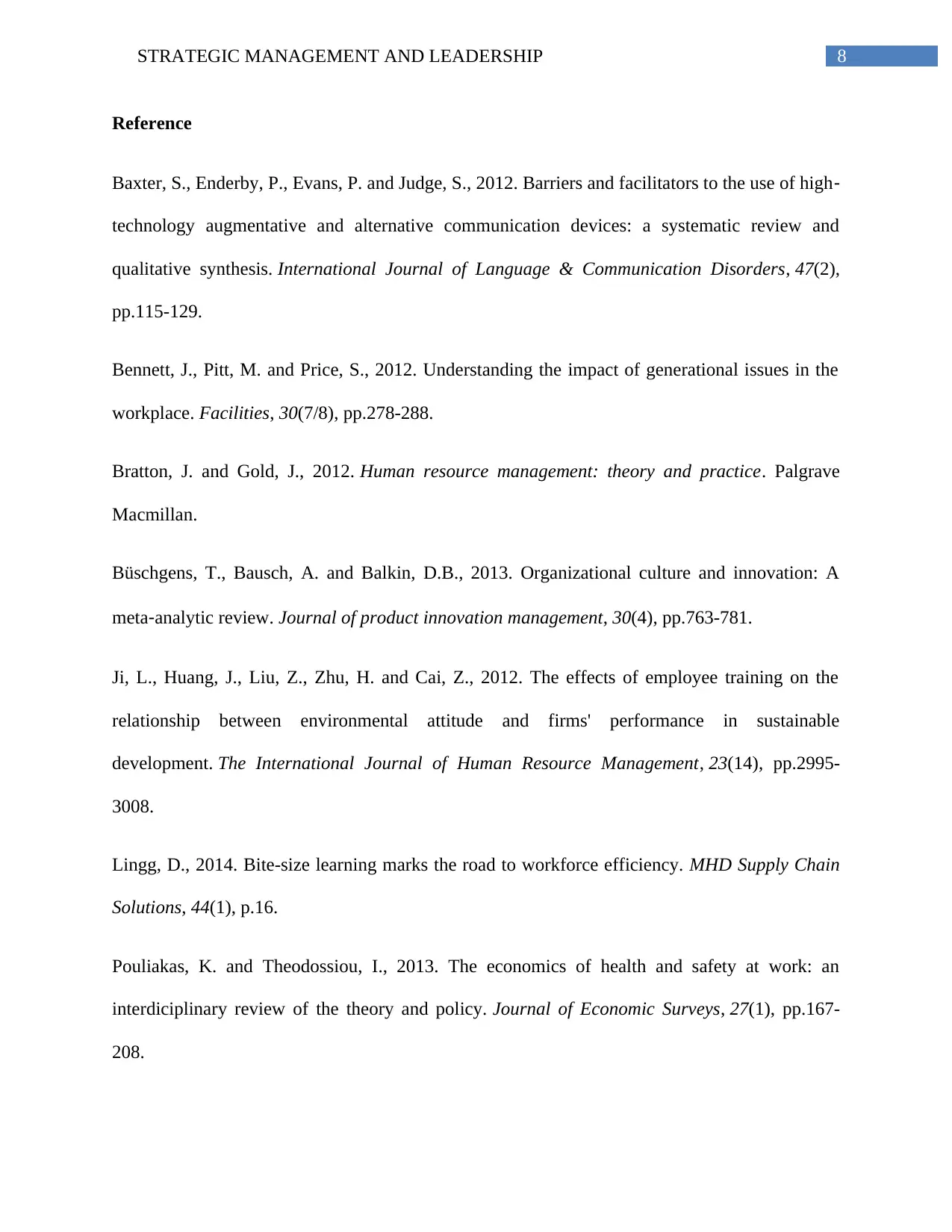
8STRATEGIC MANAGEMENT AND LEADERSHIP
Reference
Baxter, S., Enderby, P., Evans, P. and Judge, S., 2012. Barriers and facilitators to the use of high‐
technology augmentative and alternative communication devices: a systematic review and
qualitative synthesis. International Journal of Language & Communication Disorders, 47(2),
pp.115-129.
Bennett, J., Pitt, M. and Price, S., 2012. Understanding the impact of generational issues in the
workplace. Facilities, 30(7/8), pp.278-288.
Bratton, J. and Gold, J., 2012. Human resource management: theory and practice. Palgrave
Macmillan.
Büschgens, T., Bausch, A. and Balkin, D.B., 2013. Organizational culture and innovation: A
meta‐analytic review. Journal of product innovation management, 30(4), pp.763-781.
Ji, L., Huang, J., Liu, Z., Zhu, H. and Cai, Z., 2012. The effects of employee training on the
relationship between environmental attitude and firms' performance in sustainable
development. The International Journal of Human Resource Management, 23(14), pp.2995-
3008.
Lingg, D., 2014. Bite-size learning marks the road to workforce efficiency. MHD Supply Chain
Solutions, 44(1), p.16.
Pouliakas, K. and Theodossiou, I., 2013. The economics of health and safety at work: an
interdiciplinary review of the theory and policy. Journal of Economic Surveys, 27(1), pp.167-
208.
Reference
Baxter, S., Enderby, P., Evans, P. and Judge, S., 2012. Barriers and facilitators to the use of high‐
technology augmentative and alternative communication devices: a systematic review and
qualitative synthesis. International Journal of Language & Communication Disorders, 47(2),
pp.115-129.
Bennett, J., Pitt, M. and Price, S., 2012. Understanding the impact of generational issues in the
workplace. Facilities, 30(7/8), pp.278-288.
Bratton, J. and Gold, J., 2012. Human resource management: theory and practice. Palgrave
Macmillan.
Büschgens, T., Bausch, A. and Balkin, D.B., 2013. Organizational culture and innovation: A
meta‐analytic review. Journal of product innovation management, 30(4), pp.763-781.
Ji, L., Huang, J., Liu, Z., Zhu, H. and Cai, Z., 2012. The effects of employee training on the
relationship between environmental attitude and firms' performance in sustainable
development. The International Journal of Human Resource Management, 23(14), pp.2995-
3008.
Lingg, D., 2014. Bite-size learning marks the road to workforce efficiency. MHD Supply Chain
Solutions, 44(1), p.16.
Pouliakas, K. and Theodossiou, I., 2013. The economics of health and safety at work: an
interdiciplinary review of the theory and policy. Journal of Economic Surveys, 27(1), pp.167-
208.
⊘ This is a preview!⊘
Do you want full access?
Subscribe today to unlock all pages.

Trusted by 1+ million students worldwide
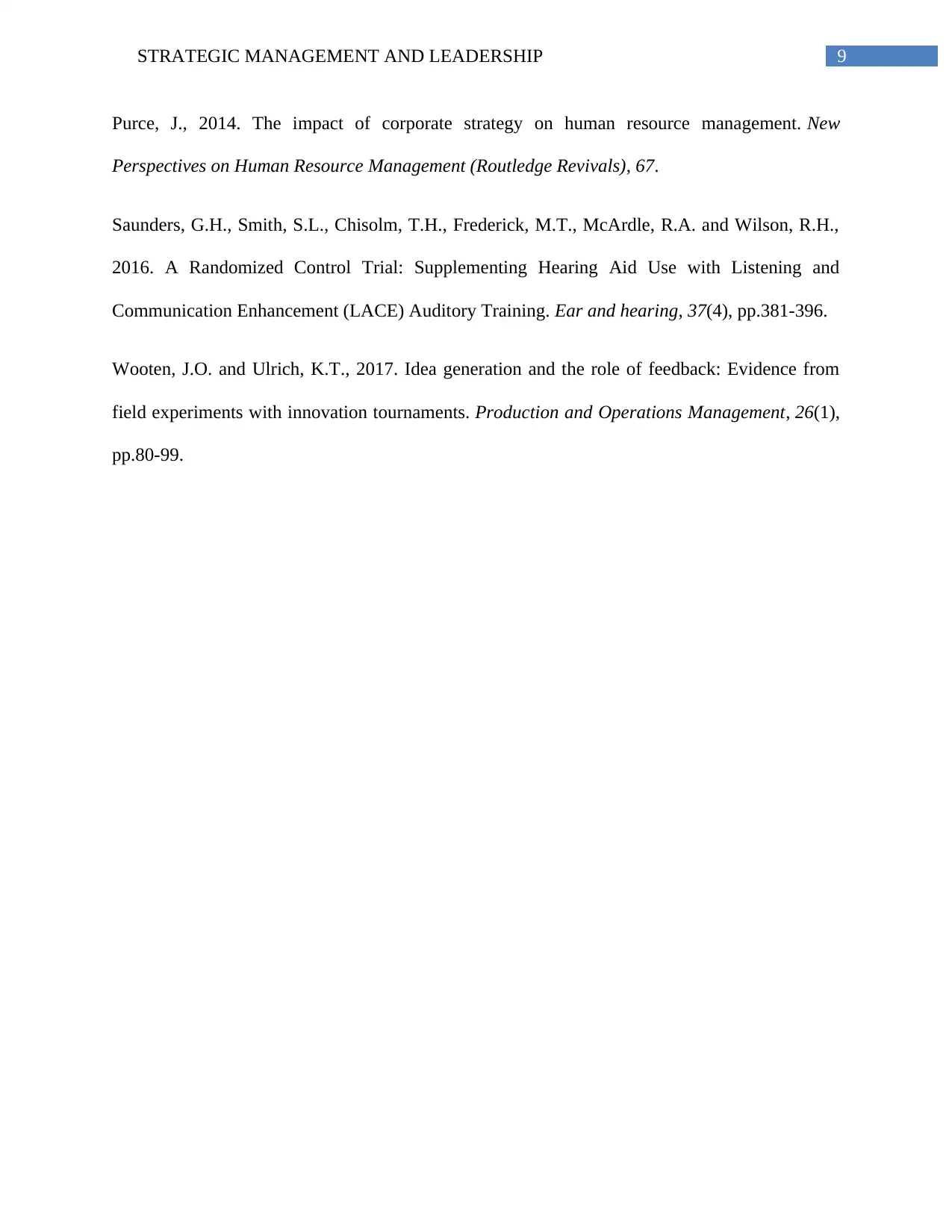
9STRATEGIC MANAGEMENT AND LEADERSHIP
Purce, J., 2014. The impact of corporate strategy on human resource management. New
Perspectives on Human Resource Management (Routledge Revivals), 67.
Saunders, G.H., Smith, S.L., Chisolm, T.H., Frederick, M.T., McArdle, R.A. and Wilson, R.H.,
2016. A Randomized Control Trial: Supplementing Hearing Aid Use with Listening and
Communication Enhancement (LACE) Auditory Training. Ear and hearing, 37(4), pp.381-396.
Wooten, J.O. and Ulrich, K.T., 2017. Idea generation and the role of feedback: Evidence from
field experiments with innovation tournaments. Production and Operations Management, 26(1),
pp.80-99.
Purce, J., 2014. The impact of corporate strategy on human resource management. New
Perspectives on Human Resource Management (Routledge Revivals), 67.
Saunders, G.H., Smith, S.L., Chisolm, T.H., Frederick, M.T., McArdle, R.A. and Wilson, R.H.,
2016. A Randomized Control Trial: Supplementing Hearing Aid Use with Listening and
Communication Enhancement (LACE) Auditory Training. Ear and hearing, 37(4), pp.381-396.
Wooten, J.O. and Ulrich, K.T., 2017. Idea generation and the role of feedback: Evidence from
field experiments with innovation tournaments. Production and Operations Management, 26(1),
pp.80-99.
1 out of 10
Related Documents
Your All-in-One AI-Powered Toolkit for Academic Success.
+13062052269
info@desklib.com
Available 24*7 on WhatsApp / Email
![[object Object]](/_next/static/media/star-bottom.7253800d.svg)
Unlock your academic potential
Copyright © 2020–2025 A2Z Services. All Rights Reserved. Developed and managed by ZUCOL.





